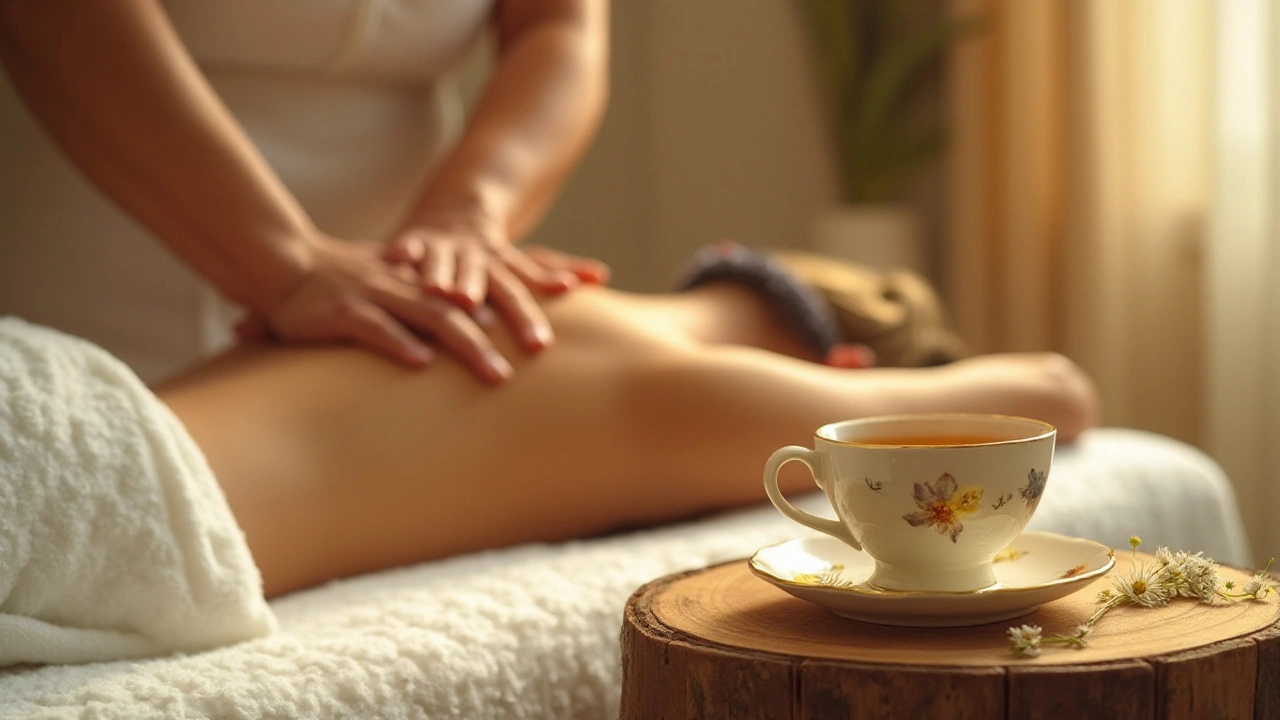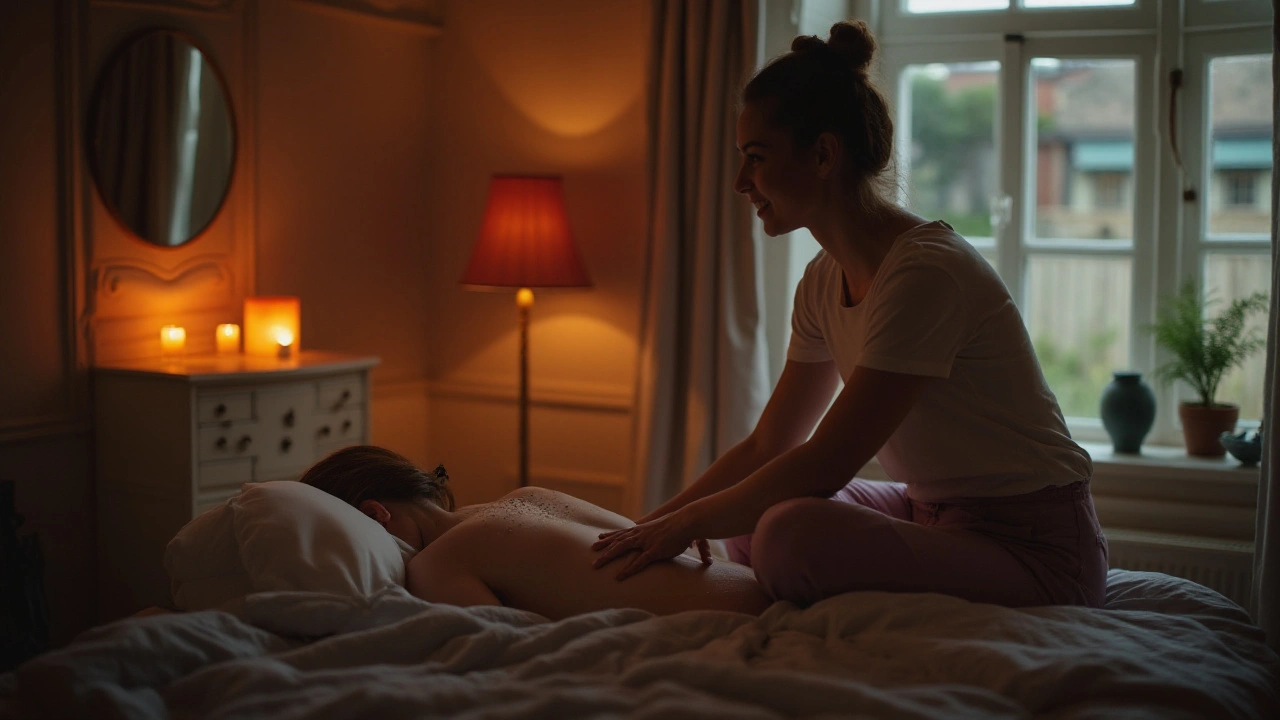Struggling with sleep can be exhausting, both mentally and physically. If you've tried everything from changing your pillow to counting sheep, you might find the answer in something more hands-on: body massages.
Body massages aren't just a luxury for pampering. They can be a powerful tool to lull your body and mind into a restful state. In this article, we'll delve into how you can use massages to significantly improve your sleep quality.
From understanding the impact of different massage techniques on your body to uncovering the science behind it, you'll find plenty of insights that could turn your sleepless nights into peaceful slumbers. Plus, real-life success stories will inspire you to give it a try. So, let's get started on the journey to better sleep through therapeutic touch.
- Understanding the Impact of Body Massages on Sleep
- Different Types of Massage Techniques
- The Science Behind Massage and Sleep Connection
- Tips for Incorporating Massages into Your Nightly Routine
- Real-life Benefits and Success Stories
Understanding the Impact of Body Massages on Sleep
It's well-known that sleep is essential for our well-being, and yet so many struggle to get a good night’s rest. Massage, often seen as a mere luxury, can actually play a significant role in improving sleep. When you receive a massage, your body undergoes various processes that prepare it for rest. But how exactly does this happen?
Firstly, body massages help in reducing stress and anxiety levels. When you're stressed, your body produces more cortisol, a hormone that can interfere with your sleep. Massages reduce cortisol levels, allowing your body to produce more serotonin. This
Different Types of Massage Techniques
When it comes to improving sleep through body massages, understanding the various techniques available can be incredibly empowering. Each type of massage offers unique benefits, and picking the right one for your needs can make a substantial difference. Here, we'll explore some of the most popular and effective massage techniques that can help you unlock better sleep.
Swedish Massage
Swedish massage is one of the most common and well-known types of massage. This technique involves long, flowing strokes, kneading, and circular movements on superficial layers of muscle. It's not only relaxing but also helps increase oxygen levels in the blood and improve circulation. Many people find that a Swedish massage helps relieve muscle tension and stress, which can consequently lead to improved sleep quality.
Deep Tissue Massage
For those dealing with chronic muscle issues, a deep tissue massage can be particularly beneficial. This technique targets deeper layers of muscle and connective tissue using slower strokes and more intense pressure. It's designed to break down knots and alleviate chronic muscle pain. Research suggests that deep tissue massages can lower blood pressure and reduce stress hormones, paving the way for a more restful night.
Hot Stone Massage
Hot stone massage involves placing smooth, heated stones on specific parts of the body. The heat from the stones helps to relax tight muscles and improve blood flow. This type of massage is incredibly soothing and is especially effective for individuals who have trouble relaxing. The warmth permeates deep into muscle tissues, promoting relaxation and making it easier to drift off to sleep.
According to Dr. Maria Hernandez-Reif, a leading researcher in massage therapy, "Hot stone massages can be a particularly effective method for releasing deep muscle tension and promoting relaxation, which are essential for a good night's sleep."
Aromatherapy Massage
Aromatherapy massage combines the benefits of massage with the therapeutic properties of essential oils. Oils like lavender and chamomile are well-known for their calming effects. During an aromatherapy massage, these essential oils are either inhaled through a diffuser or absorbed through the skin. The gentle, rhythmic motions combined with the soothing scents can significantly lower anxiety levels and make falling asleep much easier.
Shiatsu Massage
Originating from Japan, Shiatsu massage employs finger pressure in a rhythmic sequence along the body's energy pathways. This technique is rooted in traditional Chinese medicine and aims to balance the body's energy, known as qi. By addressing these energy imbalances, Shiatsu massage can help to alleviate symptoms of insomnia and promote better sleep.
Reflexology
Reflexology is based on the idea that specific points on the feet, hands, and ears are connected to various organs and systems in the body. By applying pressure to these points, a reflexologist can help relieve tension and promote relaxation. Many people find reflexology to be incredibly calming, and it can be a particularly effective way to induce sleep.
Head and Neck Massage
A head and neck massage focuses on massaging the scalp, neck, and shoulders. This technique is especially useful for those who suffer from headaches or neck pain. Gentle kneading and circular strokes on these areas can increase blood flow and release tension, making it easier to relax and fall asleep.
By exploring and understanding these various massage techniques, you can find the one that best suits your individual needs. Whether you prefer the gentle strokes of a Swedish massage or the deep pressure of a deep tissue massage, incorporating massages into your routine can be a game-changer for your sleep quality. Each technique has its own set of benefits, but they all share the common goal of promoting relaxation and reducing stress, which are key to a better night's sleep.

The Science Behind Massage and Sleep Connection
When it comes to improving sleep quality, understanding the science can be quite revealing. One of the key reasons why massage can enhance your sleep is its ability to reduce stress. When you’re stressed, your body produces higher levels of cortisol, commonly known as the stress hormone. Elevated cortisol levels not only make it harder to fall and stay asleep, but they also lead to poorer sleep quality. A good massage can lower cortisol levels, thereby reducing stress and paving the way for more restful sleep.
Another fascinating aspect of massages is their ability to increase serotonin production. Serotonin is a neurotransmitter that plays a crucial role in regulating our mood and sleep. Increased serotonin levels can help your body produce more melatonin, the hormone responsible for regulating your sleep-wake cycle. When your serotonin and melatonin levels are balanced, falling asleep becomes easier, and you are more likely to enjoy deeper, more restorative sleep.
Studies have confirmed these benefits. For instance, research published in the International Journal of Neuroscience showed that participants who received massages experienced a significant decrease in their electromyography (EMG) readings—a measure of muscle tension. Lower muscle tension is directly related to relaxation, making it easier for you to drift off to sleep. Additionally, other studies have confirmed that massage therapy can decrease the activity of the hypothalamic–pituitary–adrenal (HPA) axis, the body’s central stress response system, further showing how massages help in reducing overall stress levels.
According to Tiffany Field, director of the Touch Research Institute at the University of Miami, “By reducing the key stress hormone cortisol, massages help promote a balanced state of the entire nervous system, making it easier for you to transition into sleep.”
Beyond hormones and neurotransmitters, massages can also enhance sleep by improving circulation. Improved blood flow ensures that your muscles receive an adequate supply of oxygen and nutrients, helping them to recover and heal more efficiently. This is particularly beneficial if you lead an active lifestyle or have a physically demanding job. Enhanced circulation also facilitates the removal of waste products like lactic acid from the muscles, reducing discomfort and promoting relaxation.
Moreover, various massage techniques can target specific trigger points in your body, relieving pain and tension that might be making it difficult for you to sleep. Techniques such as Swedish massage, known for its gentle and calming strokes, or deep-tissue massage, which focuses on releasing deep muscle tension, can be particularly effective. These methods not only alleviate pain but also promote a sense of well-being, further assisting you in achieving a peaceful night’s sleep.
The link between better sleep and massage is undeniable. The combination of reduced stress, balanced hormones, improved circulation, and targeted pain relief can make a substantial difference in your sleep quality. Understanding these scientific connections doesn't just demystify how massages work; it also empowers you to make informed decisions about incorporating them into your nightly routine.
Tips for Incorporating Massages into Your Nightly Routine
Creating a calming bedtime ritual that includes a massage can make a big difference in your sleep quality. To begin with, a consistent night-time routine signals to your body that it's time to wind down. Start by setting aside 15-30 minutes each evening dedicated just to relaxation. You don't need a professional massage therapist for this—simple self-massage techniques can do wonders.
First, create a soothing environment. Dim the lights, play some gentle music, and perhaps diffuse a calming essential oil like lavender or chamomile. The ambiance sets the mood for relaxation, making your massage experience more effective. Having a specific spot, like a comfortable chair or your bed, can also help create a ritualized practice that your body will associate with winding down.
Next, focus on areas where you hold the most tension. For many people, the neck and shoulders are prime targets. Use your fingers to gently knead these areas, applying light to moderate pressure. Imagine you're kneading dough—use small, circular motions and adjust pressure as needed. Take deep breaths as you do this to help your entire body relax.
Your feet work hard all day and are often neglected, but they're crucial for overall relaxation. Spend a few minutes each night massaging them. Using a tennis ball to roll under your foot can be very effective. This not only relieves tension in your feet but also has a calming effect on your entire body. Massage therapists often recommend focusing on the heels and balls of the feet, as these areas tend to accumulate a lot of stress.
Including your hands in the massage routine can also be very relaxing. Our hands are constantly working, and we often don't realize how much tension we build up. Use a lotion or massage oil for this, as the glide can make the massage more enjoyable. Work from the base of your palm to the tips of your fingers, using your thumb to apply gentle pressure. Rotate each finger softly to release any built-up tension.
A nightly massage routine can also benefit from some simple tools. A foam roller, for example, can be used to relieve muscle tightness and improve blood flow. Roll it gently along your back and thighs, focusing on any particularly tight areas. This not only helps to relax your muscles but also aids in faster recovery if you engage in physical activities during the day.
"Consistency is key when it comes to reaping the benefits of a night-time massage routine,” says renowned massage therapist Emma Stone. “The more regularly you incorporate it into your nightly schedule, the more you’ll find your body naturally relaxing and preparing for sleep.”
Another tip is to practice mindfulness during your massage. Pay attention to how your body feels under your touch. This mindfulness can help to amplify the relaxation and make the experience more satisfying. Also, don't be afraid to mix things up. Some nights you might want a longer massage, while other nights a brief session will suffice. Listen to your body and adjust accordingly.
Incorporating these therapeutic massages into your nightly routine won't just help you fall asleep faster; it will also improve your sleep quality. Over time, you'll find that you wake up feeling more refreshed and ready to face the day. With a few simple adjustments and a bit of consistency, your bedtime massage routine can become the highlight of your evening.

Real-life Benefits and Success Stories
Many people have experienced significant improvements in sleep quality thanks to body massages. Let's dive into some real-life stories and statistics that prove just how effective these techniques can be. Take Jane, for example. She struggled with insomnia for years, trying everything from medications to meditation apps. A friend recommended regular massages, and Jane decided to give it a shot. Within a few weeks, she noticed a dramatic difference. Her nights were no longer spent tossing and turning. Instead, she found herself drifting off almost as soon as her head hit the pillow. Steady massages reduced her stress, allowing her mind and body to relax, leading to better sleep.
Another remarkable case is John, a 45-year-old office worker who used to suffer from chronic back pain, which kept him awake at night. John began incorporating therapeutic massages into his weekly routine. Over time, the massages eased his muscle tension and alleviated his pain, allowing him to enjoy uninterrupted sleep. Surprisingly, the quality of his sleep wasn’t just improved; he also reported waking up feeling more refreshed and energized.
According to the American Massage Therapy Association, 'Regular massage therapy helps reduce stress hormone levels and heart rate, which can improve sleep.' This insight has been echoed by many health professionals who recognize the beneficial impact of massages on sleep quality.
Statistics also support these anecdotal successes. A study published in the Journal of Clinical Sleep Medicine found that individuals receiving consistent massages reported a 50% reduction in the time it took them to fall asleep and a 60% increase in deep sleep phases. It’s fascinating to see how touch can make such a difference. Research has shown that massages stimulate the production of serotonin, a neurotransmitter that plays a crucial role in managing sleep cycles. Increased serotonin levels lead to better nights and more productive days.
Incorporating massages into your daily routine might seem daunting, but here’s where personal stories can be inspiring. Lisa, a mother of two, manages to fit a quick 15-minute self-massage session into her tight schedule. She used to wake up multiple times during the night, but ever since she started her nightly ritual, her sleep has been more restful. Her simple strategy includes focusing on pressure points on her feet and shoulders, using a simple massage roller. Her testimony underscores an essential fact: you don’t necessarily need professional help to reap the benefits of massage therapy. Small, consistent efforts at home can yield significant improvements.
Let’s discuss the variety of techniques that can be beneficial. For those who can, Swedish massages are highly recommended. This technique uses long, gliding strokes and can be incredibly effective for inducing relaxation. Another effective method is aromatherapy massage, where calming essential oils like lavender are used. Lavender is known for its relaxing properties that assist in sleep improvement. Deep tissue massage focuses on the deeper layers of muscle and is ideal for releasing chronic tension, which, in turn, can make your body more receptive to rest.
Additional Tips
If you're interested in trying massage therapy for better sleep, it's worth considering a few tips to maximize the benefits. First, ensure you're well-hydrated both before and after your sessions. Hydration helps in flushing out toxins released during the massage. It’s also helpful to communicate openly with your therapist about your specific sleep issues so that they can tailor the techniques to fit your needs. For those opting for self-massage, there are many online tutorials available that guide you step-by-step. Consistency is key, so try to incorporate these sessions into your nightly routine.


 Health and Wellness
Health and Wellness